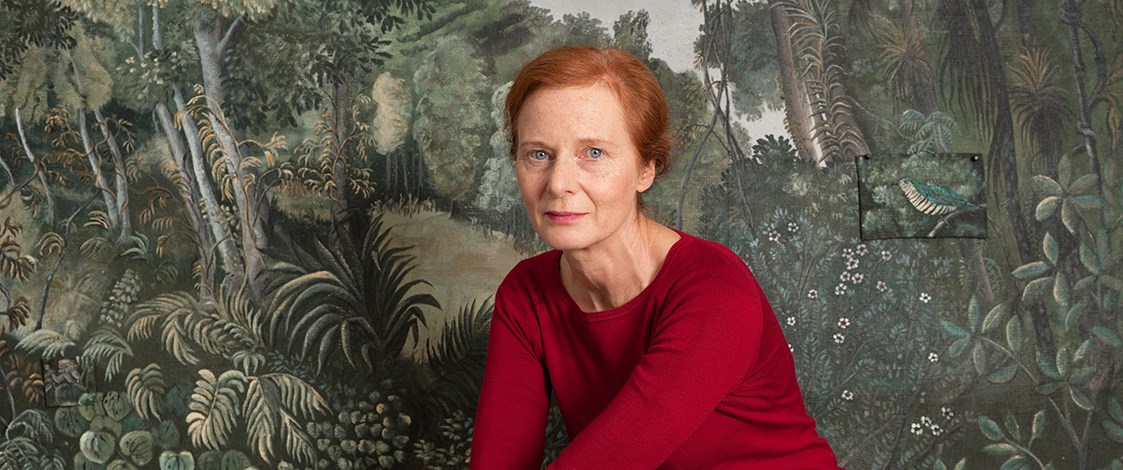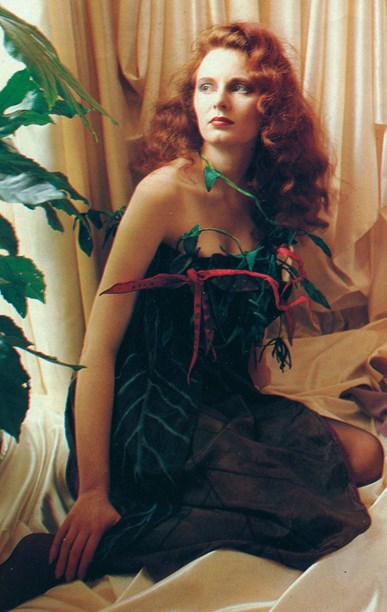Stories
Kerrie Hughes
1959-

Kerrie Hughes' garments have been acquired by fashion collectors all over the world, including a printed silk velvet evening dress designed for Liberty's Christmas window that is part of the permanent collection at London's V&A Museum.
Although she now resides in her hometown, Wellington, she has spent a large part of her career working in London, where her designs under the label Idol featured on television shows including Absolutely Fabulous and Friends, and in magazines such as Vogue, Tattler and Elle.
Born in 1959 in Lower Hutt, Kerrie was taught to sew by her father, William Hughes, who was the head of men’s suit manufacturer, Rembrandt. "He gave me a few lessons on an industrial sewing machine at the age of about 13," she recalls.
Kerrie spent two years in a dressmaking apprenticeship before enrolling at the Wellington Polytechnic to study Clothing and Textiles in 1978. She became friends with another student, Di Jennings, and after graduation in 1979 they began their own business, Svelt. They started by working from the basement of Di’s Wellington home, then opened a workroom and retail store in Cuba Street.

Kerrie Hughes models one of her designs, The Dominion Post, 1980. Image courtesy of ALexander TUrnbull Library, EP-Industry-Fashion-Flair-General 1980-02.
Kerrie and Di staged regular fashion shows at Wellington nightspots, such as Chips and The Last Resort. Hedonistic happenings, rather than sales exercises, the events provided lots of outrageous hair, performance, music and dancing. Their flair for the avant garde attracted clients such as flamboyant Fair Go TV presenter Judith Fyfe, actress Ellie Smith, a three-woman cabaret act called the Velvet Vipers and singer Trudi Green of The Neighbours.
In 1982 they moved north to a bigger and, they hoped, more adventurous market in Auckland. In a More magazine article (1984) called 'How To Sew Up A Rag Trade Career', Cecile Geary wrote, "Svelt is a tiny shop in the newly restored Queen’s Arcade. Hung with cream satin curtains draped tent-like across ceiling and walls, it resembles the kind of hideaway a sultan might retire to with one of his harem on an afternoon off. On every side, pouffed, puffed, ruched and richly glittering garments catch the light as well as the eye."

Kerrie Hughes in the Svelt shop in Auckland, More magazine, 1983. Image © More magazine.
Auckland did not prove to be the label's salvation and Kerrie returned to Wellington and established a new solo label, Siren. In 1984 and in 1985 she won a Highly Commended award in the Benson & Hedges Fashion Design Awards and in 1986 she won a Queen Elizabeth II Arts Council and Craft Council grant to study the costume collections at the Metropolitan Museum of Art, the Los Angeles County Museum and the V&A in London.
It was while she was in London that she enrolled at the Central St Martin’s College of Art and completed an MA in Fashion. "At St Martins, the head of the course was Bobby Hillson, also the now deceased Louise Wilson, and Chris Matthews," she says. "What did I learn there? How to be critical. All learning was done through criticism. How to think in terms of fashion and looking current. It made students competitive in preparation for the tough world of the fashion industry."
As well as her formal training, Kerrie worked for a few months with Zandra Rhodes and then for the British evening wear designer Murray Arbeid, as an assistant designer in 1989. His clients included Lady Diana Spencer and Shirley Bassey. "I learnt a lot from the pattern cutter Lesley Poole at Murray Arbeid. Lesley was also the pattern cutting tutor at St Martins and the Royal Collage, and he would make the patterns as paper sculptures on a stand first then take them down and make them into a flat pattern."
In 1990 Kerrie established the label for which she is perhaps best known internationally, Idol. Together with Penny Meachin, they designed made and sold their through their shop in Soho. "I met Penny, a fellow New Zealander, through another friend," she recalls. "She had the shop in Soho with another friend, and when I first met them I immediately liked them a lot. I visited them one day and Deborah had just told Penny she didn't want to do it any more and Penny was trying to work out a way to keep the shop going by herself. It was miraculous as their set up was so like the shops I had had, with the workroom out the back behind the scenes. So I jumped in and said how about if I came in and we shared costs?"
"When we started in London we only made for the shop, and then decided we needed to wholesale as well," she says. "We made a small collection and could not afford to show at London Fashion week to start with but luckily a woman who owned a shop in New York, Charivari, spotted me wearing a jacket she liked and ordered. That started us off. They showed at London Fashion Week between 1991-2000, and became a big success."
Things took off once Charivari started stocking the Idol label. I think that gave us a seal of approval. The woman who owned the shop was friends with the owner of Whistles in London, so Whistles then placed an order, then, seeing that, Liberty’s did, and so it went from there. We fitted well with the image of Liberty’s which has as its ethos the Arts and Crafts movement. We were the modern version of that." Idol went on to be stocked in other major retail outlets in Europe and the United States, including Harvey Nichols, Browns, Henri Bendel, Bergdorf Goodman, Saks, Nordstrom and Neiman Marcus. An outfit that was specially created in 1995 for the Christmas window display at Liberty, the department store in Regent Street, London is now part of the permanent collection at the V&A Museum.
Kerrie describes the Idol style as dressy, individualistic, hand crafted, unique and feminine. "We did not really follow fashion trends, but hoped to tap into the psyche of the owner, to make beloved almost talismanic objects that would be kept for a long time. Those objectives have never changed. The customers were hard to put in a box, non conformists. To tell the truth I always felt that we worked outside the fashion scene in New Zealand and London."
International exposure in the A-Z of fashion magazines helped secure celebrity clients including Cher, Annie Lennox, Paula Yates, Tracey Ullman, Helena Bonham Carter, Charlotte Church and Marilyn Manson. "Marilyn Manson bought a cotton tulle white cap sleeved embroidered top. Paula Yates bought a lot of evening clothes for a Hello shoot about her, but I remember a blue embroidered corset because it was in all the photos of her in the press after she died," she says.
Idol was part of a new breed of independent designers beating their own path. The dresses and suits were made in a hands on time-consuming fashion. "It was all made by people working for us in London, so it worked out to be very costly," Kerrie says. "The work like embroidery was part of the making process as opposed to something that could be done on a machine or by a factory, usually over the top of seams."
But in 2000 they decided to call it quits. "Penny and I closed the shop in London in 2000. We had both become mothers. The business fluctuated year by year, but never seemed to improve. When I had my son, we made a decision that if things had not improved in five years when he was due to start school we would give it up, and that is what happened," she says.
Today, Kerrie is back in New Zealand and working as an artist, something that she says she has always wanted to do. Her favourite parts of working in fashion were the photo shoot and the shows - telling a visual story through clothing and styling.
Her art often explores the art of handstitching. "I have always been drawn to intricate handwork. I love it. When starting out in New Zealand in the early 1980s, we did not have much fabric to choose from so we would have to find a way to add something ourselves. It also creates a sort of story. It invokes something."
In 2010 Kerrie made four fairy tale white wedding gowns decorated in hand embroidery for an exhibition, White Goddess, that was staged with the milliner, Liza Foreman. She spent 18 months creating the exhibition backdrop - ceiling-height fake tapestry screens. The show led her to Bowen Gallery in Wellington, which now represents her work. Her second exhibition, in February 2016, included five Tapeter, the Scandinavian version of scenic wallpapers. Kerrie deployed them to create atmospheric backdrops for images of the elaborate handcrafted clothes she continues to make, most recently under the label Vague for Wellington department store, Kirkcaldie & Stains.
Detail and craftsmanship are still a big part of the equation, but her style has evolved. "In the past, I was making clothing I wanted to wear myself. Now that I am in my 50s I find that the clothing that is most appropriate for me is subdued and chic, nd this isn't really the type of clothing I make," she says. "I can't say that I have a philosophy. But behind what I make is the idea of expressing the desires of the female, and clothing as a means of expression."
Text by Liza Foreman. Banner image by Stephen A'Court. Image © Kerrie Hughes.
Last published September 2017.